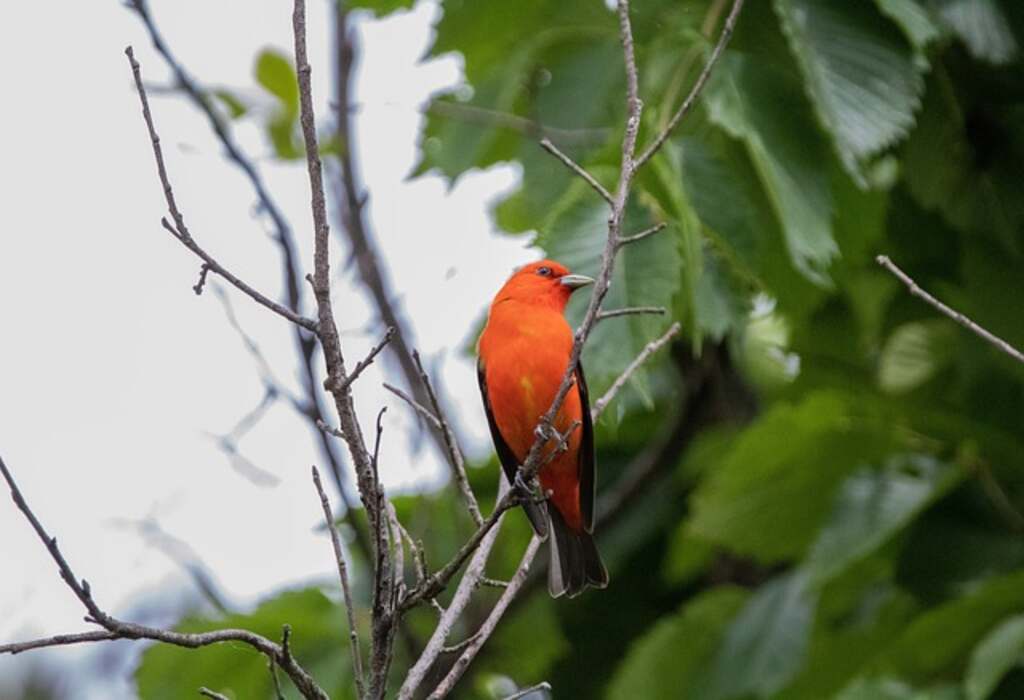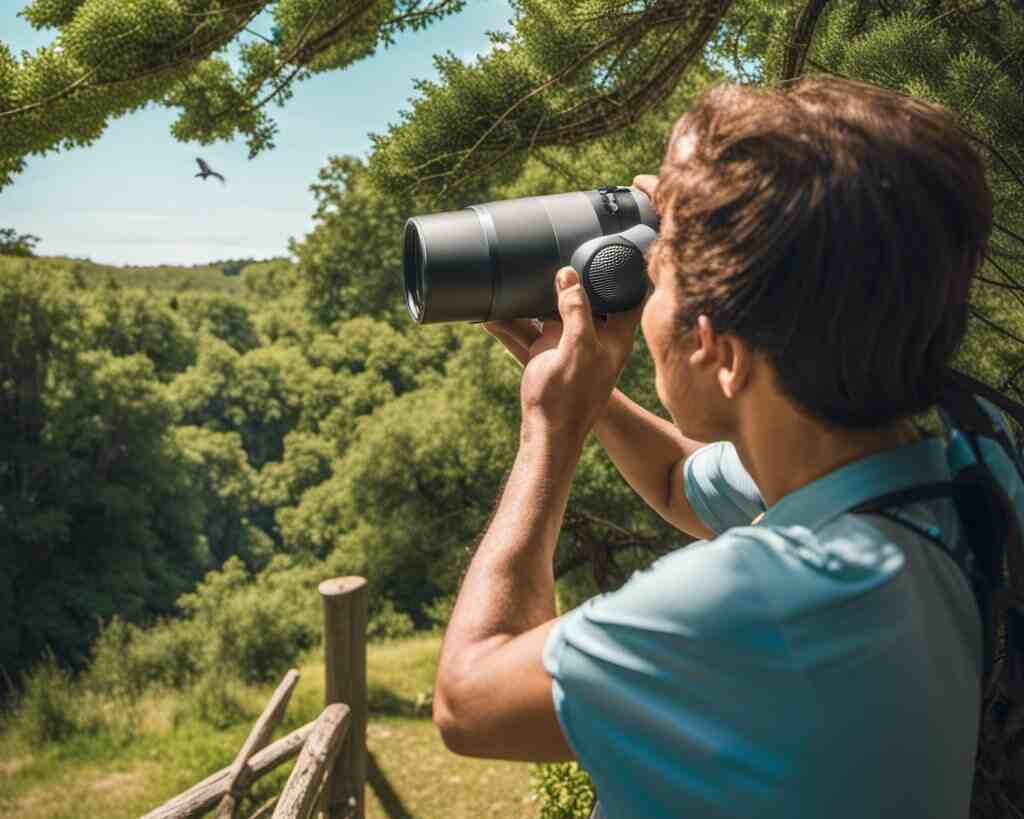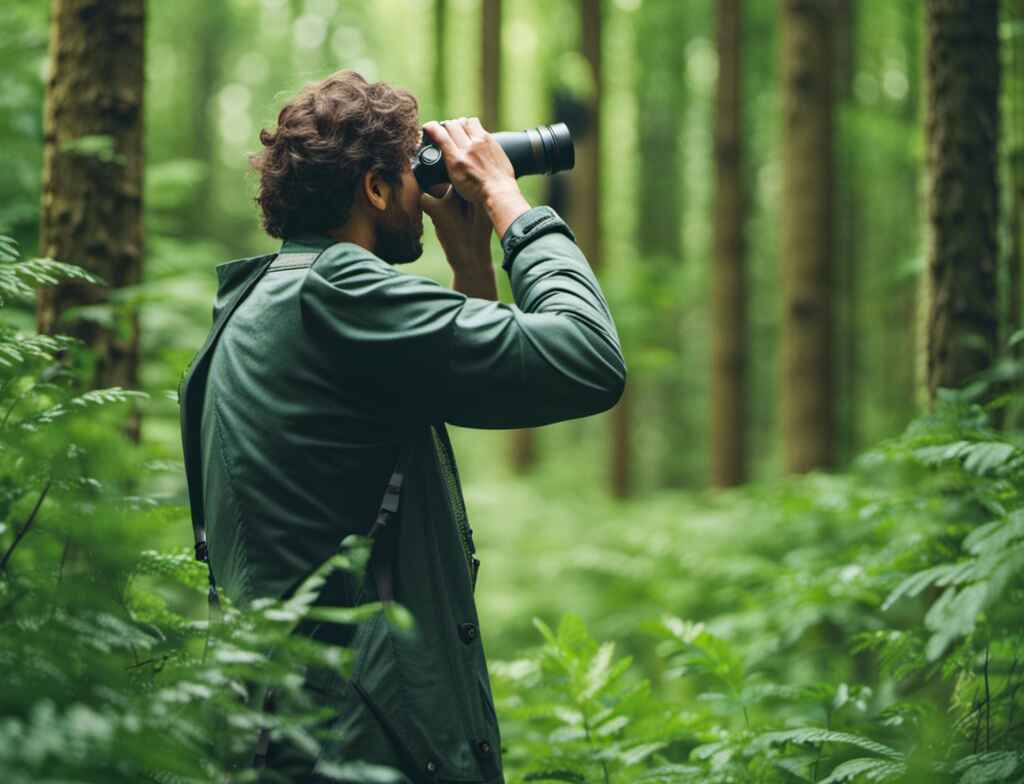Birdwatching, a popular recreational activity, coincides with the desire for freedom and the appreciation of nature. Alabama, with its diverse landscapes, offers a plethora of hotspots for avid bird enthusiasts.
This article aims to explore a selection of these hotspots, providing detailed information for those seeking to experience the beauty of Alabama’s avian inhabitants.
Whether you are a seasoned birder or a beginner, these Birdwatching hotspots in Alabama promise an enriching and awe-inspiring birdwatching experience.
Table of Contents
- 1 Key Takeaways
- 2 Best Birdwatching Hotspots In Alabama
- 3 Dauphin Island
- 4 Wheeler National Wildlife Refuge
- 5 Gulf Shores
- 6 Monte Sano State Park
- 7 Wheeler Dam
- 8 Sauta Cave National Wildlife Refuge
- 9 Cheaha State Park
- 10 Bankhead National Forest
- 11 Eufaula National Wildlife Refuge
- 12 Wheeler Wildlife Refuge
- 13 Oak Mountain State Park
- 14 Lake Guntersville State Park
- 15 Frequently Asked Questions
- 15.1 What is the best time of year to visit these birdwatching hotspots in Alabama?
- 15.2 Are there any guided birdwatching tours available in these areas?
- 15.3 Are there any specific species of birds that are commonly spotted in these hotspots?
- 15.4 Are there any restrictions or permits required for birdwatching in these locations?
- 15.5 Are there any nearby accommodations or camping options for visitors to these birdwatching hotspots?
- 16 Conclusion
- 17 Author
Key Takeaways
- Alabama offers diverse habitats for birdwatching.
- Migration stopover sites are important for various bird species.
- Birdwatching during migration stopover helps preserve stopover habitats and understand migratory patterns.
- Join guided birdwatching tours or attend birdwatching events to enhance skills.
Best Birdwatching Hotspots In Alabama
Alabama offers a range of exceptional birdwatching hotspots for enthusiasts. Some of the top locations include Gulf Shores, renowned for its coastal bird species.
Monte Sano State Park and Cheaha State Park provide diverse habitats, attracting a wide variety of bird species.
Wheeler Dam and Wheeler National Wildlife Refuge are known for their abundant bird populations, while Sauta Cave National Wildlife Refuge offers a unique experience with its cave-dwelling birds.
Nature lovers can explore Bankhead National Forest and Eufaula National Wildlife Refuge, which provide ample opportunities to spot a variety of bird species.
Additionally, Wheeler Wildlife Refuge, Oak Mountain State Park, and Lake Guntersville State Park are popular destinations for birdwatching, offering beautiful landscapes and a rich birdlife to observe and appreciate.
Dauphin Island
Dauphin Island in Alabama has emerged as a renowned birdwatching destination due to its unique geographical location, providing a diverse habitat for a wide range of bird species.
Birdwatching enthusiasts can explore numerous birdwatching spots on Dauphin Island, including:
- Gulf Shores
- Monte Sano State Park
- Wheeler Dam
- Wheeler National Wildlife Refuge
- Sauta Cave National Wildlife Refuge
- Cheaha State Park
- Bankhead National Forest
- Eufaula National Wildlife Refuge
- Wheeler Wildlife Refuge
- Oak Mountain State Park
- Lake Guntersville State Park
These locations offer a variety of bird habitats, attracting species such as the American Bald Eagle and the Great Blue Heron.
Dauphin Island is particularly notable for its role as a stopover site during bird migration, making it a prime location for observing a wide array of bird species.
With its diverse bird species and picturesque landscapes, Dauphin Island is a haven for birdwatchers seeking a memorable and enriching experience.
Wheeler National Wildlife Refuge
Situated in the northern part of the state, Wheeler National Wildlife Refuge is renowned for its diverse avian population and serves as a crucial stopover for migratory birds along the Mississippi Flyway.
With over 300 species of birds documented, the refuge provides ample birdwatching opportunities for enthusiasts.
The refuge’s varied habitats, including bottomland hardwood forests, wetlands, and open fields, attract a wide range of bird species throughout the year.
Birdwatchers can observe waterfowl such as ducks and geese, as well as wading birds like herons and egrets. Additionally, the refuge is home to numerous raptors, including bald eagles and ospreys.
Visitors can explore the refuge’s extensive trail system, which offers prime viewing locations and the chance to spot rare and elusive species.
Wheeler National Wildlife Refuge truly offers a haven for birdwatchers seeking to observe and appreciate the rich avian diversity of Alabama.
Gulf Shores
Located on the southern coast of Alabama, Gulf Shores is a popular destination for beachgoers and nature enthusiasts alike, offering pristine white sand beaches, crystal clear waters, and abundant marine life.
In addition to its natural beauty, Gulf Shores is also a haven for birdwatching activities.
With its diverse coastal habitats, including marshes, dunes, and forests, the area attracts a wide variety of bird species throughout the year.
Some of the notable bird species that can be spotted in Gulf Shores include the Reddish Egret, Least Tern, Black Skimmer, and the endangered Piping Plover.
Birdwatchers can explore the Bon Secour National Wildlife Refuge and Gulf State Park, which provide excellent opportunities for observing these feathered creatures in their natural habitats.
Gulf Shores truly offers a unique and rewarding birdwatching experience for enthusiasts of all levels.
Monte Sano State Park
Monte Sano State Park offers visitors the opportunity to experience the breathtaking beauty of a mountain park while also providing a haven for a diverse array of bird species.
The park’s scenic landscapes and diverse habitats make it an ideal location for birdwatching enthusiasts.
Keep a keen eye out for the Scarlet Tanager and Red-eyed Vireo, as these species are known to frequent the park’s woodlands.
Take in the scenic beauty and birdlife of this mountain park
Nestled within the picturesque mountains, visitors can immerse themselves in the captivating natural surroundings and diverse avian species that inhabit Monte Sano State Park.
This scenic park offers an ideal location for birdwatching enthusiasts, providing a plethora of birdwatching opportunities and breathtaking views.
To make the most of their birdwatching experience, visitors should consider a few essential tips. First, it is advisable to bring binoculars and a field guide to help identify the various bird species.
Secondly, the best time to visit the park for birdwatching is during the spring and fall migration seasons, when a wide variety of migratory birds pass through the area.
Additionally, early morning and late afternoon tend to be the most active times for birdwatching, as birds are more active during these periods.
By following these birdwatching tips and choosing the optimal time to visit, visitors can fully appreciate the scenic beauty and birdlife of Monte Sano State Park.
Keep an eye out for species like the Scarlet Tanager and Red-eyed Vireo
Visitors to this mountain park can appreciate the diverse avian species that inhabit the area, including the vibrant Scarlet Tanager and the melodious Red-eyed Vireo.
The Scarlet Tanager (Piranga olivacea) is a striking bird with its bright red plumage and black wings. It can be found in the upper canopy of deciduous forests, where it forages for insects and fruits.
Birdwatchers can increase their chances of spotting this species by listening for its distinctive song, which resembles a robin’s but with a more hoarse and burry quality.
The Red-eyed Vireo (Vireo olivaceus) is another common bird in this mountain park. It is known for its repetitive song, which sounds like ‘here I am, where are you?’
This species can be found in the middle to upper parts of the forest canopy, where it feeds on insects and spiders.
For optimal birdwatching, visitors should bring binoculars and a field guide to help identify and observe these fascinating avian species.
Wheeler Dam
Wheeler Dam is an important birdwatching location in Alabama, particularly during the migration stopover period.
This site offers opportunities to observe a variety of bird species, including the Bald Eagle and Osprey.
The dam’s location and surrounding habitat make it a favorable resting and feeding spot for these birds during their long journeys.
Observe birds during their migration stopover
During their migration stopover, birdwatchers have the opportunity to witness the awe-inspiring spectacle of birds resting and refueling in Alabama’s birdwatching hotspots.
These stopover sites play a crucial role in the migration patterns of various bird species.
Alabama’s diverse habitats offer a wide range of resources for birds during their journey, including abundant food sources and suitable resting areas.
By observing bird species during their migration stopover, birdwatchers can contribute to scientific research and gain a deeper understanding of the intricate patterns and behaviors involved in bird migration.
To illustrate the importance of migration stopover, a table is provided below showcasing three bird species commonly observed during their stopover in Alabama:
| Bird Species | Migration Period | Notable Characteristics |
|---|---|---|
| Ruby-throated Hummingbird | Spring and Fall | Feeds on nectar and insects, travels long distances |
| Wilson’s Warbler | Spring and Fall | Bright yellow plumage, forages in shrubbery |
| Red-eyed Vireo | Spring and Fall | Known for its melodious song, often seen in tree canopies |
Birdwatching during migration stopover not only allows for the observation of fascinating bird species but also contributes to our understanding of their migratory patterns and the importance of preserving their stopover habitats.
Look for species like the Bald Eagle and Osprey
During their migration stopover in Alabama, birdwatchers have the opportunity to observe a diverse range of species.
In addition to the countless other birds that pass through the state, two notable species that can be spotted are the Bald Eagle and Osprey.
Alabama provides suitable habitats for the Bald Eagle, with its extensive coastline, large rivers, and abundant wetlands.
These majestic birds can often be seen perched on trees or soaring high in the sky, searching for their next meal.
The Osprey, on the other hand, showcases fascinating migration patterns.
These birds travel long distances from their breeding grounds in North America to their wintering grounds in South America, making frequent stopovers in Alabama to rest and refuel.
Birdwatchers can witness their impressive fishing skills as they dive into the water to catch fish with their sharp talons.
As observers, we are privileged to witness these incredible birds in their natural habitats.
Sauta Cave National Wildlife Refuge
Located in northeastern Alabama, Sauta Cave National Wildlife Refuge is an impressive birdwatching hotspot known for its diverse avian species and captivating natural beauty.
This refuge offers a unique opportunity for birdwatchers to observe a variety of bird species in their natural habitat.
Sauta Cave provides a sanctuary for several notable bird species, including the Bald Eagle and Osprey, making it a must-visit location for bird enthusiasts.
When birdwatching in Sauta Cave, it is essential to follow some tips to maximize your experience.
Firstly, it is advisable to bring binoculars or a spotting scope to observe birds from a distance without disturbing their natural behavior.
Secondly, wearing earth-toned clothing and moving slowly and quietly can help you blend into the surroundings and avoid startling the birds.
Additionally, it is crucial to respect the refuge’s rules and regulations, such as staying on designated trails and not disturbing nesting areas.
Overall, Sauta Cave National Wildlife Refuge offers a remarkable birdwatching experience with its diverse bird species and picturesque environment.
Birdwatchers can immerse themselves in the beauty of nature while observing these magnificent creatures in their natural habitat.
Cheaha State Park
Nestled in the northeastern part of the state, Cheaha State Park presents a captivating wilderness retreat, offering visitors an opportunity to immerse themselves in the breathtaking natural beauty of the region.
This park is not only a haven for outdoor enthusiasts but also a prime location for birdwatching.
Birdwatchers flock to Cheaha State Park throughout the year, but the best time to visit for birdwatching is during the spring and fall migration seasons.
During these times, a wide variety of migratory birds pass through the park, making it a hotspot for birdwatchers.
For beginners interested in birdwatching at Cheaha State Park, here are some helpful tips:
- Bring binoculars and a field guide to help identify different bird species.
- Be patient and observant, as birds are often camouflaged and may be difficult to spot.
- Explore different habitats within the park, such as forests, meadows, and wetlands, as each offers unique birdwatching opportunities.
- Join a guided birdwatching tour or attend a birdwatching event to learn from experienced birdwatchers and enhance your skills.
By following these tips and visiting during the appropriate seasons, birdwatching enthusiasts can have a rewarding and memorable experience at Cheaha State Park.
Bankhead National Forest
Spanning over 180,000 acres in northwestern Alabama, Bankhead National Forest is a pristine wilderness area known for its diverse ecosystems and abundant natural beauty.
The forest is a haven for birdwatching enthusiasts, offering a variety of birdwatching trails that showcase the region’s rich avian biodiversity.
These trails wind through dense forests, open meadows, and along picturesque rivers, providing ample opportunities to observe a wide range of bird species in their natural habitats.
Birdwatchers can spot migratory birds such as warblers, thrushes, and waterfowl, as well as resident species like woodpeckers, owls, and songbirds.
In addition to its birdwatching trails, Bankhead National Forest also hosts birdwatching festivals throughout the year, attracting bird enthusiasts from near and far.
These festivals offer educational programs, guided hikes, and opportunities for birdwatchers to connect with fellow nature lovers, making Bankhead National Forest a must-visit destination for birdwatching enthusiasts.
| Trail Name | Length (miles) | Difficulty Level |
|---|---|---|
| Sipsey Wilderness Trail | 12 | Moderate |
| Brushy Lake Trail | 3.5 | Easy |
| Owl Creek Trail | 6 | Moderate |
| Turkey Foot Trail | 8.2 | Difficult |
| Payne Creek Trail | 5.5 | Moderate |
Eufaula National Wildlife Refuge
Moving on from the Bankhead National Forest, another notable birdwatching hotspot in Alabama is the Eufaula National Wildlife Refuge. Spanning over 11,000 acres, this refuge provides ample birding opportunities for enthusiasts.
The Eufaula National Wildlife Refuge is renowned for its diverse bird species, attracting avian enthusiasts from far and wide.
Situated along the Chattahoochee River, the refuge’s varied habitats, including wetlands, forests, and open fields, offer a rich environment for birds to thrive.
This diverse ecosystem supports an impressive array of bird species, with over 300 documented in the area.
Birdwatchers can expect to encounter a wide range of species, including waterfowl, shorebirds, wading birds, and neotropical migrants.
With its abundant bird species diversity and picturesque landscapes, the Eufaula National Wildlife Refuge is a must-visit destination for any avid birdwatcher in Alabama.
Wheeler Wildlife Refuge
Situated along the Tennessee River, Wheeler National Wildlife Refuge is home to an impressive variety of bird species, with over 300 documented in the area, making it a significant destination for bird enthusiasts.
The refuge covers approximately 35,000 acres of diverse habitats, including wetlands, forests, and open fields, providing ample opportunities for observing and studying birds in their natural environment.
Birdwatchers at Wheeler Wildlife Refuge can employ various techniques to enhance their experience, such as using binoculars, spotting scopes, and field guides to identify different species.
The best time for birdwatching at the refuge is during the spring and fall migration periods when a wide range of bird species pass through the area.
During these times, the refuge becomes a bustling hub of avian activity, offering birdwatchers a chance to witness the beauty and diversity of migratory birds in action.
Oak Mountain State Park
Covering over 9,000 acres, Oak Mountain State Park offers a diverse range of ecosystems and recreational activities for visitors to engage with nature and immerse themselves in the natural beauty of the park.
The park’s abundant birdwatching activities make it a popular destination for bird enthusiasts.
With its scenic trails and varied habitats, Oak Mountain State Park provides an ideal environment for observing a wide variety of bird species.
The park is home to more than 200 species of birds, making it a haven for birdwatchers.
The birdwatching community at Oak Mountain State Park is active and vibrant, with regular birdwatching events and clubs that offer opportunities for enthusiasts to connect and share their passion.
Additionally, the park’s picturesque landscapes provide excellent bird photography opportunities, attracting photographers from near and far.
Whether you are a beginner or an experienced birdwatcher, Oak Mountain State Park is a must-visit destination for any bird lover.
Lake Guntersville State Park
Lake Guntersville State Park offers an opportunity to explore the diverse bird habitats along the lake. With its varied landscapes and abundant water resources, the park attracts a wide range of bird species.
Birdwatchers visiting the park can keep an eye out for iconic species such as the American Bald Eagle and Great Blue Heron, which can often be spotted in the area.
Explore the diverse bird habitats along the lake
Nestled amidst the verdant landscapes, Lake Guntersville State Park offers an enchanting haven for a wide array of avian species.
Exploring the diverse bird habitats along the lake provides an opportunity to discover a rich variety of birdwatching trails and learn about different bird species.
The park boasts a range of habitats, including forests, wetlands, and open water, which attract a multitude of avifauna.
These habitats support a diverse range of bird species, including waterfowl, wading birds, raptors, and songbirds.
Bird enthusiasts can observe species such as the bald eagle, great blue heron, red-tailed hawk, and ruby-throated hummingbird.
With over 350 bird species documented in the park, it is a treasure trove for birdwatchers and researchers alike.
Exploring the bird habitats along Lake Guntersville is a rewarding experience that offers a glimpse into the fascinating world of Alabama’s avian biodiversity.
Keep an eye out for species like the American Bald Eagle and Great Blue Heron
The diverse bird habitats along the lake offer birdwatchers a unique opportunity to observe a wide variety of species in their natural environment.
Among the many remarkable birds that can be spotted in these habitats are the American Bald Eagle and Great Blue Heron.
The American Bald Eagle, known for its majestic appearance and impressive wingspan, is a symbol of strength and freedom.
The Great Blue Heron, on the other hand, is a tall and elegant bird that can often be seen wading in shallow waters, patiently waiting for its prey.
Both of these species are of great conservation concern, as their populations have faced significant declines in the past.
Birdwatchers can contribute to conservation efforts by practicing responsible birdwatching techniques, such as maintaining a safe distance from the birds and avoiding disturbing their habitats.
By doing so, they can help ensure the continued presence of these magnificent species for future generations to enjoy.
Some interesting birdwatching techniques to enhance your experience:
- Use binoculars or spotting scopes to get a closer look at the birds without disturbing them.
- Learn to identify bird calls and songs, which can help locate species that may be hidden from view.
Frequently Asked Questions
What is the best time of year to visit these birdwatching hotspots in Alabama?
The optimal birdwatching seasons in Alabama vary depending on the specific hotspot, but generally, spring and fall are ideal due to migration patterns. To maximize bird sightings, visit these hotspots during early morning or late afternoon, bring binoculars, and familiarize yourself with local bird species.
Are there any guided birdwatching tours available in these areas?
Guided birdwatching tours and birdwatching equipment rentals are available in these areas, providing opportunities for enthusiasts to explore the diverse avian species found in Alabama. These services cater to individuals seeking a comprehensive and immersive birdwatching experience.
Are there any specific species of birds that are commonly spotted in these hotspots?
Common species of birds found in Alabama hotspots include the Northern Cardinal, Eastern Bluebird, and American Goldfinch. Tips for identifying different bird species in these areas include observing plumage color, size, and behavior.
Are there any restrictions or permits required for birdwatching in these locations?
Permits are not required for birdwatching in Alabama, but it is important to follow rules and regulations. Birdwatchers should respect the wildlife and their habitats, maintain a safe distance, and avoid disturbing the birds.
Are there any nearby accommodations or camping options for visitors to these birdwatching hotspots?
Accommodation options and camping facilities are available near the birdwatching hotspots in Alabama, providing visitors with convenient places to stay. These facilities cater to the needs of nature enthusiasts, offering a comfortable and immersive experience amidst the natural surroundings.
Conclusion
Alabama is home to several birdwatching hotspots that offer diverse habitats and a wide variety of bird species. These hotspots include Dauphin Island, Wheeler National Wildlife Refuge, Gulf Shores, Monte Sano State Park, Wheeler Dam, Eufaula National Wildlife Refuge, Wheeler Wildlife Refuge, Oak Mountain State Park, and Lake Guntersville State Park.
Each of these locations provides unique opportunities for bird enthusiasts to observe and study different avian species in their natural habitats. By visiting these hotspots, birdwatchers can deepen their understanding of the ecological importance of birds and contribute to their conservation.
As the saying goes, ‘A bird in the hand is worth two in the bush,’ reminding us of the value of appreciating and protecting the birds we have today.







